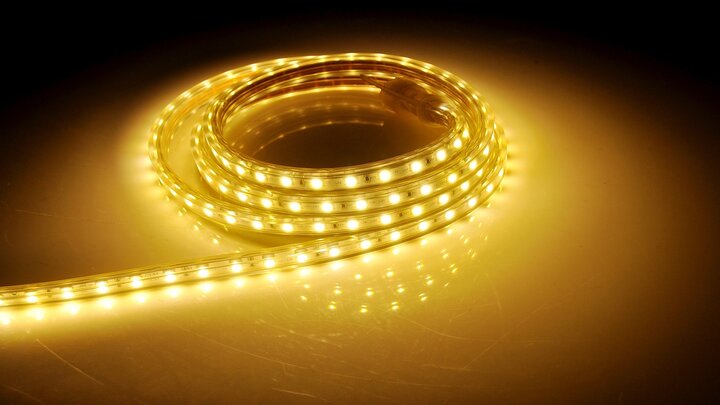LED strip lights do not use a lot of electricity like traditional incandescent lights. In fact, the annual operating cost of a 15 ft light-emitting diode strip light averages about $11. In other words, they will not significantly increase your electric bill if you leave them on all night for a year.
Switching from incandescent bulbs to LED strip lights for necessary spaces in your home or plant house also has other benefits besides slashing your monthly electric bill.
In this guide, I will show you how much electricity different LED strip lights should consume, the reasons behind their cost-effectiveness, and how they are immensely beneficial.
You will also learn about the possible risks of leaving these lights on all night.
Why Do LED Strip Lights Consume Less Electricity?

LED strip lights consume less energy compared to incandescent bulbs because they:
1. Leverage efficiency
Traditional incandescent bulbs produce light by heating a thin tungsten filament with high electricity. When enough heat is generated, photons (light) are produced.
On the other hand, LED strip lights rely on a diode or semiconductor. This semiconductor is exposed to foreign materials (doped) to alter its natural properties. This modification allows the semiconductor to possess two ends separated by a p-n junction.
One end is responsible for receiving electrons while the other contains holes that must be filled with electrons. This results in the production of photons. Since electrons flow in one direction in strip lights and do not need to be trapped, they are not energy efficient.
2. Produces less heat
Since incandescent bulb depends on heat generation, about 95% of electrical energy goes into heat production. This means only 5% goes into infrared light.
Most of the electrical energy in LED strip lights goes into light production. A lot less goes into heat generation, usually when the semiconductor is inefficient.
Hence, it is safe to say strip lights can produce as much brightness as incandescent bulbs with less heat generation.
How Much Electricity Do LED Strip Lights Use?
Assume you have 15-foot-long standard 1.46-watt LED stop lights and the average power price in your area is $0.1059 per kilowatt-hour (kWh).
To calculate the wattage of your strip light under a sufficient power supply, this is the formula to use:
Wattage = LED power rating x LED strip length
In other words:
Wattage = 1.46 (W/ft) x 15 (ft) = 21.9 Watts (W)
To calculate how much electricity these strip lights use, you must multiply Wattage by the operating time of the light strip and divide the result by 1,000.
This simply means:
Power consumption = [Wattage x Operating Time] / 1,000
Power Consumption = [21.9 W x 12 hours] / 1,000 = 0.2628 kWh
Now that we know the power consumption of the strip light let’s see how much it impacts your electricity bill:
Electricity Cost = Power Consumption x Electricity Price
Electricity Cost = (0.2628 kWh) x ($0.1059kWh) = $0.03
This estimate shows how much electricity LED strip lights consume for 12 hours (half a day). So if you use it for 24 hours, expect it to consume double (about $0.06).
Benefits of LED Strip Lights
Aside from consuming less electricity, LED strip lights boast other amazing benefits such as:
- The production of a specific light spectrum is required for plants to grow. If you own a greenhouse (at surface level or underground, these lights can initiate photosynthesis efficiently.
- Since they also produce less heat compared to fluorescent and HPS lights, you don’t have to spend much on cooling systems at home, in offices, or even in plant houses.
- They are adaptable and can produce calming or soothing lights that aid sleep. This is a major reason why some homeowners leave them on all night.
FAQs
Are LED lights safe in bedrooms?
LED lights are safe in the bedroom.
They produce less heat compared to conventional bulbs and are very adaptive.
How long can LED strip lights stay on?
LED strip lights have an expectancy of about 50,000 hours.
This means they can last up to 17 years or more, which is more than what you get from incandescent or fluorescent lights.
Do LED strips damage walls?
LED strip lights do not damage walls.
Factors like adhesive strength for gluing the strip lights, climate, and surface durability are usually responsible for wall damage.
Conclusion
LED strip lights are super efficient regarding how much electricity they consume. They are bright, last longer, and are very modern. One LED bulb is equivalent to nine conventional bulbs.
In general, their consumption solely depends on the power rating of each LED and the quality of the LED used in the strip. For example, if the power rating on each LED of a strip light is 2W, one with 20 pieces would have a rating of 40W (20 x 2W).
I hope you found this guide helpful. You can use LED strip lights if you own a plant house and wish to keep it warm without electricity. For other options, please see my guide on how to keep a greenhouse warm without electricity.
Thank you for reading.

